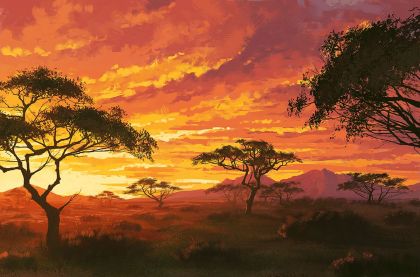Difference between revisions of "Savanna (range)"
Tao alexis (talk | contribs) |
Tao alexis (talk | contribs) |
||
| Line 47: | Line 47: | ||
* [[Natural Orchard]] | * [[Natural Orchard]] | ||
* [[Pond]] | * [[Pond]] | ||
| − | * [[Rocky | + | * [[Rocky Knoll]] |
* [[Ruin]] | * [[Ruin]] | ||
* [[Sandpit]] | * [[Sandpit]] | ||
Revision as of 23:05, 12 September 2020
Savanna is a mixed woodland-grassland environment characterized by trees spread sufficiently wide apart so that the canopy does not close. The tree density may be high and regularly spaced, or trees may be widely scattered. The prevalence of large herbivorous creatures and seasonal periods of fire ensure that there is little ground shrubs, but fast-growing grasses commonly grow to six feet (elephant grass may reach ten feet). These areas are found in the central parts of continents, away from the coasts, between 5° and 15° from either side of the equator.
The savanna climate has a distinctive wet season from May to October, with rainfall equalling that of the Equatorial rainforest; the dry season is desert-like, lasting from November to April. This cycle is determined by the location of the Trade Winds, which delineates a parkland savanna, with many trees, from a dry savanna, with scattered trees, or a parched savanna where trees occur hardly at all upon a sandy, scrub-covered soil. Most water entering the ground goes to replacing soil moisture instead of adding to groundwater; in the dry season, this water evaporates away, so that wells and water holes will run dry, forcing persons to rely on large water sources or stored water for months at a time.
Degrees of savanna form as belts along the south edge of the Sahara Desert in Africa, from south to north:
The land enables a culture that is a mixture of pastoralists and agriculturalists, whose identity is affected by the sprawling plains that encourage nomadism. The presence or absence of water exerts a strong influence over local culture, with the former creating cities, lush environments and irrigated cultivation, and the latter demanding trials in managing flocks that are herded over fast-denuded sparse grazing lands. Herders will burn large tracts to improve grazing quality and enlarge the grasslands at the expense of woodlands.
Major Savannas
Below is a list of the most extensive savannas in the world:
- Arnhem & Cape York - undiscovered Australia
- Caatinga - dry savanna, interior northeastern Brazil
- Cerrado - central Brazilian plateau
- Chapparal - California and Baja Peninsula
- Gran Chaco - lowland natural region of the Rio de la Plata
- Horn of Africa - dry savanna in far east Africa
- Llanos Orinoco - sedimentary basin in Venezuela
- Mexican Altiplano - dry savanna, north and central Mexico
- Middle Salween Basin - central Burma
- Puna - highland plateau in Peru
- Riverina & Darling River Basin - undiscovered Australia
- Sahel - progressive savannas from Senegal to Sudan
- Serengeti - east Africa along the Great Rift Valley
- South Congo Basin - dense savanna between the Congo and Angola
- Southwest Australian Savanna
Common Features
Below is a list of elements and features that are common to savanna ranges:
Savanna Creatures
The following monsters are common to savanna ranges.
- Ankheg
- Ant (giant black)
- Ant (giant bull)
- Ape (carnivorous)
- Axe Beak
- Baboon (mandrill)
- Bat (giant)
- Boa Constrictor
- Boar (warthog)
- Boar (wild)
- Bulette
- Cheetah
- Couatl
- Cougar
- Crocodile
- Dog (wild)
- Dragonne
- Elephant (Asiatic)
- Emu
- Frog (huge)
- Fungus (violet)
- Giant (hill)
- Hippogriff
- Hippopotomus
- Hyena
- Jackal (golden)
- Jackalwere
- Jaguar
- Lamassu
- Leopard
- Lion
- Lion (spotted)
- Lizard (megalania)
See List of Ranges

